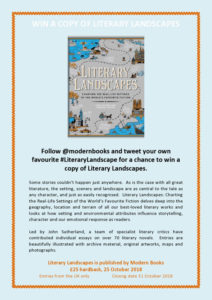
ShortBookandScribes #BlogTour #Extract from Literary Landscapes, edited by John Sutherland @modernbooks @alisonmenziespr #Giveaway
Something a little a different for you today. At the beginning of the year, I reviewed Literary Wonderlands. Modern Books have now brought out a companion book, Literary Landscapes and I have a lovely extract to share with you today. My thanks to Alison Menzies for asking me to take part in the blog tour.
![]()
Celebrating the most memorable realist landscapes in classic and contemporary fiction
Literary Landscapes draws together those well-loved authors who are synonymous with a place and time, celebrating Hardy’s Wessex, Joyce’s Dublin and Du Maurier’s Cornwall. It comes right up to date with recent bestsellers, such as Eleanor Catton’s Booker Prize winning The Luminaries, Armistead Maupin’s Tales of the City and Elena Ferrante’s My Brilliant Friend. Its charm lies in the way these favourites are interspersed with the unfamiliar, providing much to explore.
Led by John Sutherland, a team of specialist literary critics have contributed individual essays on over 70 literary novels where landscape is as central to the tale as any character, and just as easily recognized. Entries are beautifully illustrated with archive material, original artworks, maps and photographs. International in breadth and scope, Literary Landscapes is an enchanting read that book lovers will not be able to resist dipping into.
![]()
Ashdown Forest, East Sussex, England
- A. Milne
WINNIE-THE-POOH (1926) by Daniel Hahn
“If you go to Ashdown Forest today you will also discover, among other things, a bridge over a little stream – newly restored now, and right by the car park – which is just perfect for a game of Pooh-Sticks. And indeed, the real Christopher Robin used to play the game on this same spot, though he couldn’t remember which came first: did his playing precede and inspire the story, as his forest adventures sometimes did? Or were his games inspired by the stories, since the book world of Pooh and friends would also furnish his imaginary play around Cotchford for years after? (He would get into some trouble when the gardener’s wife got her foot caught in his newly dug heffalump trap.)
How precisely certain aspects of the books’ topography correspond to specific details still existing in the forest is a matter of debate. Is the old quarry really Roo’s sandy pit? What ever happened to the six pines that are supposed to be close to the heffalump trap? Which tree in the 100 Aker Wood is Owl’s house? And where exactly should you be heading if you’re on an Expotition to the North Pole?
… There is still a ‘Five Hundred Acre Wood’ today (reduced to a mere 100 for the books); there are clusters of trees, just where the map tells us there should be clusters of trees; and of course there’s the pine-crowned hilltop of Gills Lap, which becomes the books’ Galleons Lap, which is at the forest’s top, and is its most enchanted place.”
![]()


